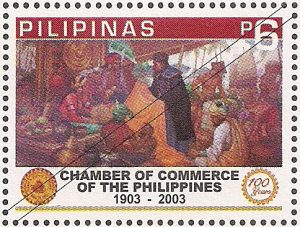Trivia about the Chamber of Commerce of the Philippines Foundation (CCPF)
The Chamber of Commerce of the Philippines Foundation (CCPF), traces its beginnings to the Camara de Comercio de Filipinas established by virtue of the Royal Decree of April 19, 1886 issued by the Queen Regent Maria Cristina of Spain. At the end of the Spanish regime on July 19, 1903, the Chamber of Commerce of the Philippines (CCP) was incorporated with the officers and members of the Camara de Comercio de Manila (which later became the Camara de Comercio de Filipinas) as founding members, indicating the continuity of the institutional identity. This continuity is further evidenced by the fact that the symbolical elements composing the logo and seal of CCPF are identical to those used by the Camara de Comercio de Filipinas.
The CCP was the only trade and commerce group comprising Spanish and Filipino traders. CCP members like Gonzalo Puyat, Toribio Teodoro and Ramon Fernandez started to espouse the cause of Filipino entrepreneurship to such an extent that they gave birth to the National Economic Protectionism Association (NEPA), which was established to protect Philippine industry against powerful American business interests. When the war ended, the Laurel-Langley Act was in full swing, and the phrase “Filipino First” was born in the halls of the CCP. Today the CCPF continues to be a strong advocate for Philippine trade and the Filipino Small and Medium Businessmen.
Through the years, the relationship between the President of the Republic of the Philippines and the membership of the CCP has remained mutually beneficial. The President often sought the advise of the CCP, especially its president on almost all matters. The CCP was led by people of great integrity and capability in business who earned the respect of the Filipino nation. It was usually the President of the Republic who administered the oath of office to members of the CCP.
In 1971, the CCP organized the first trade mission to the People’s Republic of China and it was the only delegation authorized by the President to become ambassadors of government, which ultimately paved the way for the establishment of our diplomatic relations with the People’s Republic of China.
During the Marcos administration, the CCP and the Philippine Chamber of Industries (PCI) were unified and gave birth to the Philippine Chamber of Commerce and Industry (PCCI).
In order to comply with certain legal conditions, the CCP was not dissolved, despite the formation of the PCCI, but instead maintained its judicial personality as a foundation and was thus renamed Chamber of Commerce of the Philippines Foundation (CCPF).
Historically therefore, the CCPF is unquestionably the grandfather and vanguard of chamberism in the Philippines and even the rest of Asia.
Stamps featuring the Chamber of Commerce of the Philippines Foundation (CCPF)

Recent Comments